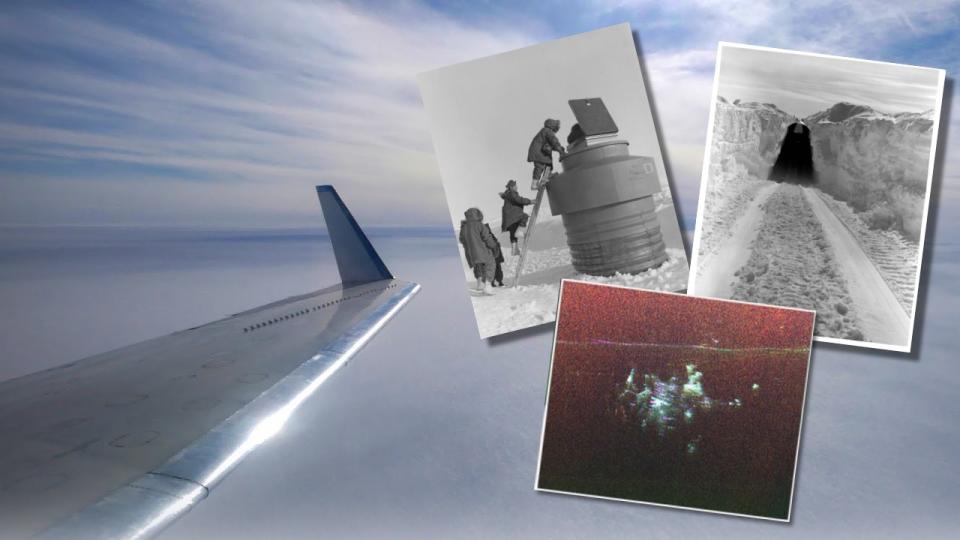When you buy through links on our articles, Future and its syndication partners may earn a commission.

Credit: NASA/US Army/Pictorial Parade/Archive Photos/Getty Images
NASA scientists conducting surveys of arctic ice sheets in Greenland got an unprecedented view of an abandoned “city under the ice” built by the U.S. military during the Cold War.
During a scientific flight in April 2024, a NASA Gulfstream III aircraft flew over the Greenland Ice Sheet carrying radar instruments to map the depth of the ice sheet and the layers of bedrock below it. The images revealed a new view of Camp Century, a Cold War-era U.S. military base consisting of a series of tunnels carved directly into the ice sheet.
Advertisement
Advertisement
As it turns out, this abandoned “secret city” was the site of a secret Cold War project known as Project Iceworm which called for the construction of 2,500 miles (4,023 km) of tunnels that could be used to nuclear intermediate range ballistic missiles (IRBMs) at the Soviet Union.
“We were looking for the bed of the ice and out pops Camp Century. We didn’t know what it was at first,” said NASA’s Chad Greene, a cryospheric scientist at the agency’s Jet Propulsion Laboratory (JPL), in an agency statement. “In the new data, individual structures in the secret city are visible in a way that they’ve never been seen before.”

a red-and-green blurry field containing white rod-like shapes
Construction on Camp Century began in 1959, but the base was abandoned in 1967 due to the costs and challenges of keeping the tunnels from collapsing in the ever-shifting ice sheet.
Project Iceworm sought to use Northern Greenland as a launch site due to its proximity to the Soviet Union and because of the remoteness of the location, according to the 2007 article “The Iceman that Never Came” published in The Scandinavian Journal of History. “The key concept was to deploy the missile force in ‘thousands of miles of cut-and-cover tunnels’, or rather covered trenches, whose floor would lie 28 feet beneath the surface,” the article states.

a crane on the left lowers a ribbed pipe on the right, attached with a large hook, lowing into an open section of embedded structure in the snow.
The trenches were designed for a type of modified Minuteman IRBM missile known as “Iceman” that would be able to withstand the pressures of launching through the ice sheet. Project Iceworm was ultimately canceled and abandoned along with Camp Century, but the echoes of this era of the Cold War still reverberate throughout the Greenland landscape today.

two walls of snow on either side show tire tracks on the ground leading to a dark tall tunnel.
Weapons, sewage, fuel and other contaminants were buried at Camp Century when it was abandoned, but the thawing Greenland Ice Sheet threatens to unbury these dangerous relics. The U.S. government even issued a statement in 2017, saying it “acknowledges the reality of climate change and the risk it poses” and will “work with the Danish government and the Greenland authorities to settle questions of mutual security” over Camp Century.

Four men, two on the left, one in middle, one on the right hoist a cross bar support beam in a tunnel. Behind them, a tall ribbed black pipe stands from floor to ceiling.
For now, though, Camp Century helps to serve as a warning and a signpost from which scientists can measure how our changing climate is affecting areas like the Greenland ice sheet. “Without detailed knowledge of ice thickness, it is impossible to know how the ice sheets will respond to rapidly warming oceans and atmosphere, greatly limiting our ability to project rates of sea level rise,” said JPL cryospheric scientist Alex Gardner in NASA’s statement.

People climb a ladder resting on the side of a pipe, standing burried in the snow.
RELATED STORIES:
Advertisement
Advertisement
— Satellite data and 100-year-old images reveal quickening retreat of Greenland’s glaciers
— Greenland ice sheets are weaker to climate change than we thought
— Huge asteroid slammed into Greenland just a few million years after the dinosaurs died out
NASA plans to use the data collected by the campaign to inform future studies of Earth’s large ice sheets.
The flights were conducted out of Pituffik Space Base, formerly Thule Air Force Base. The Space Force base is now the U.S. military’s northernmost installation and supports missile warning, missile defense and space surveillance missions.
EMEA Tribune is not involved in this news article, it is taken from our partners and or from the News Agencies. Copyright and Credit go to the News Agencies, email news@emeatribune.com Follow our WhatsApp verified Channel



